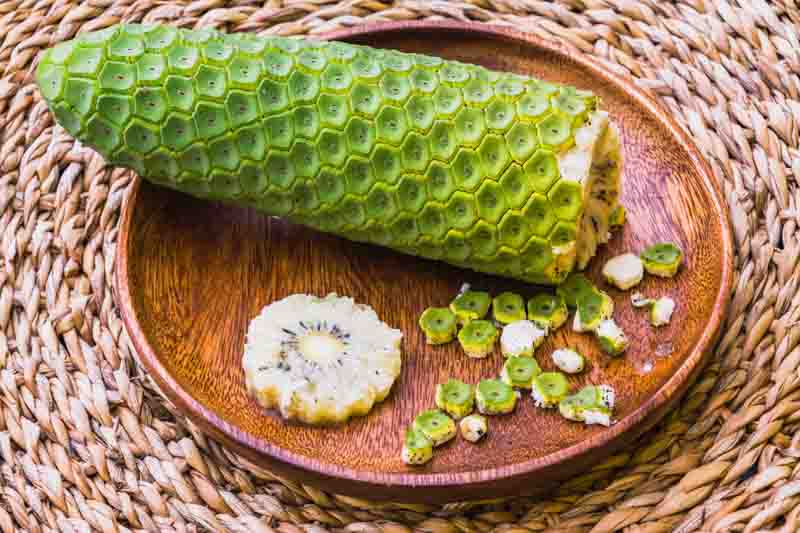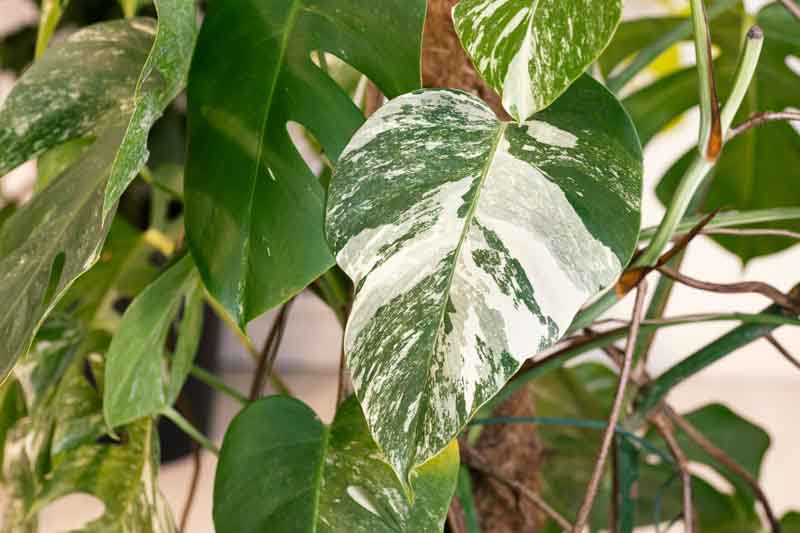Swiss Cheese Plant 'Albo Borsigiana', Variegated Swiss Cheese Plant, Variegated Monstera
Monstera deliciosa ‘Albo Borsigiana’, often simply referred to as ‘Albo’, captures the hearts of plant enthusiasts worldwide with its stunning variegated foliage. This variant of the Monstera deliciosa, distinguished by its unique white and green marbled leaves, is not just a decorative plant but a spectacle of nature’s artistry.
The ‘Albo Borsigiana’ is a highly sought-after cultivar due to its striking variegation. Unlike the common Monstera, the ‘Albo’ variety features patches of pure white or light cream on its leaves alongside the traditional deep green. This variegation occurs randomly, giving each leaf a unique pattern ranging from a few splashes of white to almost entirely pale leaves. The contrast is not just visually striking; it also adds a dramatic flair to any space it adorns.
Native: Monstera deliciosa is native to the tropical forests of southern Mexico, south to Panama. It thrives in the understory with dappled sunlight, which has adapted it well to indoor conditions. It belongs to the arum family (Araceae), along with Zantedeschia (Calla Lily), Caladium (Angel Wing), or Colocasia (Elephant Ear).
Plant Type and Habit: This cultivar is a tropical, evergreen shrub with a climbing habit, similar to its parent species. It grows by producing long aerial roots that seek support, allowing it to climb trees and other structures in its natural habitat or trellises and poles when cultivated indoors.
Size: The ‘Albo Borsigiana’ can reach impressive sizes, both in height and spread, especially when given the right conditions to thrive. Indoors, with adequate support, it can grow up to 8-10 feet tall (2.4 to 3 meters) and 3 feet wide (90 cm). Outdoors, it can reach 30 feet (9 meters) in height and 5 feet (1.5 meters) in spread.
Flowers: Like its parent species, Monstera deliciosa, the ‘Albo’ variety can produce flowers, although it’s a rare sight in indoor conditions. The flowers resemble those of the arum family, with a spadix wrapped by a spathe, but they are not the primary attraction of this plant. Flowering is more common in mature plants grown in optimal conditions, typically requiring high humidity and bright, indirect light.
Fruit: On the rare occasion that the ‘Albo Borsigiana’ flowers and is subsequently pollinated, it can produce fruit. The fruit of the Monstera deliciosa resembles a green corn cob and is known for its sweet flavor, reminiscent of pineapple and banana. However, fruiting is an uncommon occurrence in indoor environments.

Foliage: The foliage of the ‘Albo Borsigiana’ is where this plant truly shines. The leaves are large, heart-shaped, and can grow up to 3 feet (90 cm) in length in ideal conditions. The variegation presents in a stunning array of patterns, with no two leaves alike. This unpredictable variegation makes each plant uniquely beautiful, a living piece of art. The leaves also feature the characteristic splits and holes of the Monstera genus, which are said to help the plant withstand strong winds in its native habitat.
Hardiness: Monstera deliciosa is hardy in USDA zones 10-12, thriving in warm, humid conditions.
Uses: Primarily used for ornamental purposes, it’s a popular indoor plant due to its air-purifying qualities and visual appeal. Outdoors, it can be used in landscaping in tropical or subtropical climates.
Toxicity: All parts of the plant are toxic except the ripe fruits. They are toxic to humans, cats, and dogs if ingested. They contain calcium oxalate crystals that can cause mouth and stomach irritation. Contact with the sap may cause skin irritation.
Deer and Rabbits: Its toxicity generally deters deer and rabbits.
Invasiveness: In suitable climates, Monstera deliciosa can become invasive if not managed, spreading through its aerial roots and overtaking spaces. It has become a mildly invasive species in Hawaii, Seychelles, Ascension Island, and the Society Islands.
Benefits: Besides its decorative use, it’s known for purifying the air by removing pollutants, contributing to a healthier indoor environment.
Growing and caring for Monstera deliciosa, a striking tropical plant, is relatively straightforward, making it a popular choice for indoor gardeners.
Light: As a houseplant, Monstera thrives in bright summer light and winter direct sun. While it can grow under fluorescent lighting, insufficient light prevents the development of its characteristic leaf perforations.
Soil: Use a peat-based potting mix with perlite or sand to improve drainage. Monsteras prefer slightly acidic to neutral pH.
Water: Water when the top inch of soil feels dry. Monsteras like evenly moist soil but not soggy. Reduce watering in winter.
Temperature and Humidity: Ideal temperatures range from 68°F to 86°F (20°C to 30°C). Avoid exposure to temperatures below 50°F (10°C), as cold can damage the plant. Thrives in humidity levels of 60% or higher. Use a humidifier or mist the leaves regularly to increase humidity, especially in dry environments.
Fertilization: Apply a balanced, water-soluble fertilizer monthly during the growing season (spring through summer). Reduce to every other month in fall and winter.
Pruning: Prune in spring or early summer to maintain size and shape. Remove any yellow or damaged leaves to encourage new growth.
Cleaning: Dust the leaves occasionally with a damp cloth to ensure the plant can photosynthesize efficiently. This also keeps the plant looking its best.
Repotting: Repot every 2-3 years or when the plant becomes rootbound. Choose a pot 1-2 inches larger in diameter than the current one.
Climbing Support: Provide a moss pole or trellis for support, mimicking its natural climbing habit. Attach stems loosely to the support as they grow.

Propagating Monstera is a rewarding and straightforward process that allows you to create new plants from an existing one.
Monstera can encounter pests, diseases, and other common problems, especially when grown indoors.
Spider Mites: These tiny pests cause yellow stippling on leaves. Increase humidity and wash leaves with water or use insecticidal soap.
Mealybugs: Look for cottony deposits in leaf axils or undersides. Remove with alcohol-dipped cotton swabs or apply neem oil.
Aphids: Small, pear-shaped pests that cluster on new growth and undersides of leaves, sucking plant sap and weakening it. Combat them with a gentle spray of water, neem oil, or insecticidal soap to protect the plant’s health and appearance.
Scale insects: Hard, brown bumps on leaves/stems indicate scale. Scrape off manually and treat with neem oil or insecticidal soap.
Root rot: Overwatering can lead to root rot, characterized by mushy, brown roots and yellowing leaves. Ensure good drainage and allow soil to dry between waterings.
Leaf spot: Fungal or bacterial leaf spots appear as discolored patches on leaves. Improve air circulation, avoid wetting foliage, and treat with fungicides if severe.
Yellowing Leaves: Overwatering, poor drainage, or nutrient deficiencies can cause leaves to yellow. Adjust watering habits and consider repotting or fertilizing.
Brown Leaf Tips/Edges: Low humidity or drought stress might cause brown tips. Increase humidity around the plant with a pebble tray or humidifier.
Leggy Growth: Insufficient light can lead to sparse, leggy growth. Move your Monstera to a brighter location with indirect sunlight.
Fenestration Not Developing: Young plants or those not receiving enough light may not develop the characteristic leaf holes or splits. Provide brighter indirect light to encourage fenestration.
| Hardiness |
10 - 12 |
|---|---|
| Plant Type | Houseplants, Climbers, Shrubs |
| Plant Family | Araceae |
| Genus | Monstera |
| Exposure | Partial Sun |
| Season of Interest |
Spring (Early, Mid, Late) Summer (Early, Mid, Late) Fall Winter |
| Height |
8' - 30' (240cm - 9.1m) |
| Spread |
3' - 5' (90cm - 150cm) |
| Maintenance | Low |
| Water Needs | Average |
| Soil Type | Loam, Sand, Chalk, Clay |
| Soil pH | Acid, Neutral, Alkaline |
| Soil Drainage | Moist but Well-Drained |
| Characteristics | Showy, Evergreen |
| Tolerance | Deer, Rabbit |
| Garden Uses | Patio And Containers |
| Hardiness |
10 - 12 |
|---|---|
| Plant Type | Houseplants, Climbers, Shrubs |
| Plant Family | Araceae |
| Genus | Monstera |
| Exposure | Partial Sun |
| Season of Interest |
Spring (Early, Mid, Late) Summer (Early, Mid, Late) Fall Winter |
| Height |
8' - 30' (240cm - 9.1m) |
| Spread |
3' - 5' (90cm - 150cm) |
| Maintenance | Low |
| Water Needs | Average |
| Soil Type | Loam, Sand, Chalk, Clay |
| Soil pH | Acid, Neutral, Alkaline |
| Soil Drainage | Moist but Well-Drained |
| Characteristics | Showy, Evergreen |
| Tolerance | Deer, Rabbit |
| Garden Uses | Patio And Containers |
How many Monstera deliciosa ‘Albo Borsigiana’ (Swiss Cheese Plant) do I need for my garden?
| Plant | Quantity | |
|---|---|---|
| Monstera deliciosa ‘Albo Borsigiana’ (Swiss Cheese Plant) | N/A | Buy Plants |
Create a membership account to save your garden designs and to view them on any device.
Becoming a contributing member of Gardenia is easy and can be done in just a few minutes. If you provide us with your name, email address and the payment of a modest $25 annual membership fee, you will become a full member, enabling you to design and save up to 25 of your garden design ideas.
Join now and start creating your dream garden!
Create a membership account to save your garden designs and to view them on any device.
Becoming a contributing member of Gardenia is easy and can be done in just a few minutes. If you provide us with your name, email address and the payment of a modest $25 annual membership fee, you will become a full member, enabling you to design and save up to 25 of your garden design ideas.
Join now and start creating your dream garden!